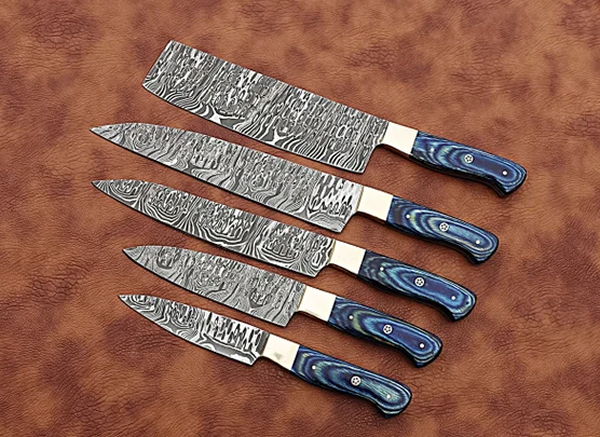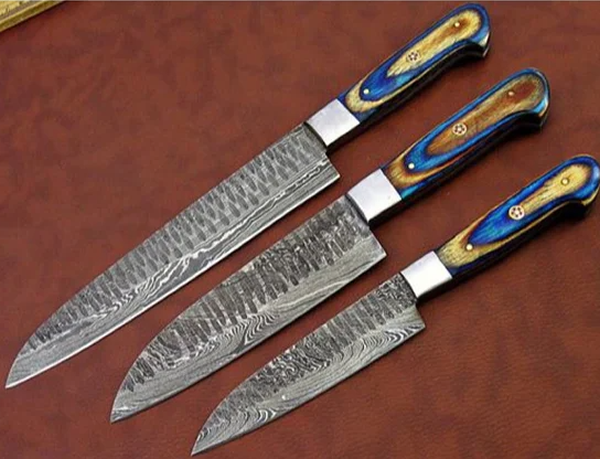Handmade knives are not just useful instruments; they are works of art in which craftsmanship and functionality coexist. Made using age old methods of knife making handed from one generation to the other, these knives epitomize the concept of sharpness, creativity and good workmanship.
In this comprehensive guide, the reader is taken on a journey through the world of hand-forged kitchen knives: the procedures of making them, the fundamentals of their materials, the aesthetics of their design, their efficiency in culinary uses, the delicate requirements of their maintenance, and differences between handmade creations and industrial imitations.

Craftsmanship and Tradition
The process of creating hand-forged kitchen knives starts from choosing appropriate materials, preferably high-carbon types that have the tendency to maintain sharpness. Even the blades for the weapons are made through forging where the artisans use a heated steel in a furnace and through the use of tools like anvil and hammer to shape the piece.
It not only forms the shape of the knife but also optimizes the metallurgical structure of the steel, making it stronger and tougher. Every strike of the hammer and every second spent in the forge is part of the overall work and helps create the knife as the embodiment of the skill and passion of the artisan.
The craft of hand forged knives is not merely functional; it is about values that are deeply imbedded in culture and a sense of tradition. Like many other products, artisans take long years of apprenticeship to learn the art of forging and each knife is not only a tool but also a piece of craft that carries history of time, effort and proficiency.
The process requires a lot of time, a high level of attention, and great knowledge of metallurgy since people mostly aim to produce knives that are not only practical but also beautiful.

Materials Used
The selection of materials in hand-forged knives plays a crucial role in their performance and durability. High-carbon steel, such as VG-10 or Aogami (Blue Steel), is favored for its ability to maintain a sharp edge through prolonged use.
These steels are known for their fine grain structure, which allows for superior edge retention and ease of sharpening. In some cases, artisans use Damascus steel, a layered steel known for its distinctive patterns created through the folding and forging of multiple layers of steel. This not only enhances the knife's visual appeal but also contributes to its strength and resilience.
Handle materials in hand-forged knives vary widely, offering both functional and aesthetic benefits. Natural materials such as hardwoods (e.g., walnut, ebony) provide warmth and character while offering a secure grip during use. Synthetic materials like Micarta or G10 offer durability and resistance to moisture, making them ideal for professional kitchens. The handle's design and ergonomics are carefully considered to ensure comfort and control, allowing chefs to work effortlessly for extended periods without fatigue.
Design and Construction
The design of hand-forged knives is a blend of functionality and artistic expression. Blades are crafted in various shapes and profiles to suit different culinary tasks, from the versatile chef's knife with its broad blade for chopping and slicing to the slender boning knife for precise meat work. The tapering of the blade, the curvature of the edge, and the thickness of the spine are meticulously honed to optimize cutting performance and balance.
Each knife is custom-shaped, ensuring that it not only performs exceptionally but also feels balanced and comfortable in the hand.
The construction of hand-forged knives extends beyond the blade to encompass the entire knife as a unified tool. Tang construction, where the blade extends into the handle, enhances the knife's strength and stability.
This ensures that the knife remains durable and well-balanced even under rigorous use. Handle designs range from classic riveted styles to modern ergonomic shapes, each crafted to enhance grip and control while reflecting the artisan's attention to detail.
Maintenance and Care
Maintaining the longevity of hand-forged kitchen knives requires diligent care and attention to detail. Regular honing with a sharpening steel or ceramic rod helps maintain the knife's edge between sharpening sessions, ensuring consistent cutting performance.
When sharpening is necessary, using high-quality whetstones allows for precise control over the blade's edge geometry and sharpness. After each use, hand-wash the knife with mild detergent and immediately dry it to prevent corrosion. Proper storage in a knife block, magnetic strip, or protective sheath protects the blade's edge and prevents accidental damage.
The care invested in maintaining hand-forged knives not only preserves their beauty and functionality but also honors the craftsmanship that went into creating them. Each knife represents a union of art and utility, deserving of meticulous care to ensure its continued performance and longevity in the kitchen.
Artisan vs. Mass-Produced Knives
Hand-forged knives crafted by artisans stand in stark contrast to mass-produced alternatives in both craftsmanship and quality. Artisan-made knives are crafted individually, allowing for greater attention to detail and customization. The forging process itself imbues each knife with unique characteristics, from the pattern of Damascus steel to the shaping of the handle. Artisans often collaborate closely with customers to create knives tailored to their specific preferences, whether in blade shape, handle material, or decorative elements.
In contrast, mass-produced knives are typically stamped from machine-cut blanks, prioritizing uniformity and cost-efficiency over personalized craftsmanship. While mass-produced knives may offer affordability and consistency, they often lack the individuality and artisanal quality found in hand-forged knives.
Cost and Investment
The cost of hand-forged kitchen knives reflects the craftsmanship, materials, and exclusivity of each piece. Artisan-made knives, crafted with precision and often customized to meet specific preferences, command higher prices compared to mass-produced alternatives.
This investment is justified by the knife's longevity, superior cutting performance, and the satisfaction of owning a unique piece of culinary craftsmanship. While initial costs may be higher, the durability and performance of hand-forged knives make them a worthwhile investment for serious chefs and passionate home cooks alike.
The cost of a hand-forged knife extends beyond its monetary value; it represents a commitment to quality, tradition, and the artistry of knife-making.
Each knife tells a story of craftsmanship and dedication, resonating with those who appreciate the finer details of culinary tools. By investing in a hand-forged knife, chefs and enthusiasts not only acquire a superior kitchen tool but also support the continuation of artisanal traditions that span centuries.
Conclusion
Hand-forged kitchen knives are more than just tools; they are testaments to craftsmanship, tradition, and the enduring pursuit of excellence in culinary artistry. From their meticulous craftsmanship and selection of materials to their exceptional performance and personalized customization, hand-forged knives embody the essence of artisanal craftsmanship. Whether you're a professional chef seeking precision in every cut or an avid home cook passionate about culinary innovation, the investment in a hand-forged knife promises not only superior performance but also a connection to a timeless craft that enriches every culinary experience.
